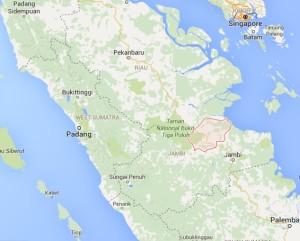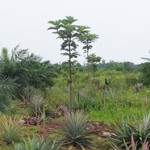Originally published at Agroforestry World Blog

Protecting peat lands to reduce CO2 emissions while securing people’s livelihoods is a challenge in Indonesia. A video released by the World Agroforestry Centre documents the background and research carried out by a team of Indonesian and international scientists to help the Tanjung Jabung Barat district government on the Indonesian island of Sumatra identify which parts of the district have been producing the most greenhouse gasses from different land uses. The research is supported by the CGIAR Research Program on Forests, Trees and Agroforestry (FTA). ICRAF’s Rob Finlayson knows more about this.
Each of the more than 400 district governments in the country is required to prepare plans to reduce greenhouse gasses as part of the national government’s commitment to bring down emissions by up to 41% by 2025. Preparing such plans is a challenge for most districts owing to a shortage of skilled staff.
The Norwegian Agency for Development Cooperation is funding a project called Securing Ecosystems and Carbon Benefits by Unlocking Reversal of Emissions Drivers in Landscapes (Secured Landscapes). Under this project, the World Agroforestry Centre has been working with the Tanjung Jabung Barat government and farmers to find land-use options that will contribute to reducing emissions.
Around 40% of the district is peat land, most of which had been covered by dense swamp forest until as recently as the 2000s, when much of the forests were removed to make way for agriculture and plantations, predominantly oil palm.
Using various techniques, such as spatial and carbon analyses, the scientists found that removing the district’s peat-swamp forests had released a lot of greenhouse gasses because of the large amount of carbon stored in the decaying, sodden, plant litter, which can be meters thick. When the trees are removed and the swamp drained, the peat becomes dry and can easily burn. The scientists also found that even after the forests had been cleared the peat was still emitting greenhouse gasses.
Benefits of peat protection
The research team argued that stopping clearance of the peat-swamp forests could more easily reduce greenhouse-gas emissions from the district compared to changing logging practices associated with timber-production forests that were mainly on mineral soils in other parts of the district.
The peat-swamp forests were cleared mostly by internal migrants from other parts of Indonesia, who sold the timber and established farms, as part of a ‘pioneering’ tradition supported historically by the government’s transmigration program, designed to move people from densely-populated areas, such as Java, to less populated regions, often to work on plantations.
Also read Collaboration key to Dyera return to peat
To try and keep the remaining forests and repair the degraded land, the district government declared peat-swamp forest land was protected and could not be cleared or used for farming. However, this mainly resulted in conflict between the government and the people who had cleared the land and now relied on it.
The migrants were often unaware that the forest they were clearing had been designated as ‘protection’ forest by the government or that they even ‘belonged’ to anyone and continued to clear the peat-swamp forests anyway. They were aided by a ‘land market’, which involved local people selling the forests or other land even though they had little or no legal right to do so. Indonesia has a long and complex history of conflicting claims over land by government, traditional communities and migrants.

From research to policy
Based on the research, the district government and the researchers agreed that rehabilitation was necessary for halting further environmental damage in the already-degraded peat-swamp forests but any such program had to address conflict over land ownership and the need to make a living.
To try and resolve these problems, the research team experimented to find the ‘best practice’ for agroforests on degraded peat land and the district forestry office started a peat-swamp rehabilitation program.
The star of that program is ‘jelutung’ (Dyera pollyphylla), a once-widespread indigenous tree. Its latex was in the past the primary ingredient of chewing gum but was also widely used in other industries. Its habitat—the peat-swamp forests—had been largely destroyed. Demand for jelutung latex had also dropped over the years and the tree had lost much of its economic value. But the government felt other markets could be found for the tree’s products.
The researchers worked with farmers and the forestry office to test different combinations of jelutung and other trees and plants—such as rubber, coffee, fruit and pineapple—that grow well on the unique qualities of peat soil.
Community forestry as the solution
The researchers also concluded that the best solution for all these problems—rehabilitating degraded land to reduce emissions and further clearing of forests, land rights and the need for farmers to make a living—was a government licence for land use known as Community Forestry (Hutan Kemasyarakatan). The licence included secure tenure as a non-financial incentive for rehabilitating land, which under certain conditions could also be used for making a living.
To promote the use of Community Forestry licences, the researchers explained the idea to local government officials and community groups. They took farmers and officials on visits to other villages that already had Community Forestry licences, mapped potential community forests with the farmers, trained them in how to plant and manage jelutung for greatest benefits, and improved the relationship between farmers and district government officials so that the process of applying for a licence would run more smoothly.
Now the farmers are working together with the scientists and the government and can look forward to great results. The jelutung and other crops are growing well and the first Community Forestry licence proposal has been submitted and awaits final approval.
The district government now has evidence and strong hope that Community Forestry on peat-swamp land will not only restore the ecological functions of the land but also improve the economic situation of the local farmers, help to mitigate the effects of climate change by storing more carbon while also securing land tenure and incomes.
The video will be used to promote the process and findings to district governments throughout Indonesia (in Indonesian) and to international audiences (in English). An animation used in the videos to promote better understanding of peat processes is also available as a separate video.












